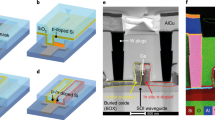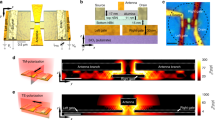Abstract
A critical challenge for the convergence of optics and electronics is that the micrometre scale of optics is significantly larger than the nanometre scale of modern electronic devices. In the conversion from photons to electrons by photodetectors, this size incompatibility often leads to substantial penalties in power dissipation, area, latency and noise1,2,3,4. A photodetector can be made smaller by using a subwavelength active region; however, this can result in very low responsivity because of the diffraction limit of the light. Here we exploit the idea of a half-wave Hertz dipole antenna (length ∼ 380 nm) from radio waves, but at near-infrared wavelengths (length ∼ 1.3 µm), to concentrate radiation into a nanometre-scale germanium photodetector. This gives a polarization contrast of a factor of 20 in the resulting photocurrent in the subwavelength germanium element, which has an active volume of 0.00072 µm3, a size that is two orders of magnitude smaller than previously demonstrated detectors at such wavelengths.
This is a preview of subscription content, access via your institution
Access options
Subscribe to this journal
Receive 12 print issues and online access
$209.00 per year
only $17.42 per issue
Buy this article
- Purchase on Springer Link
- Instant access to full article PDF
Prices may be subject to local taxes which are calculated during checkout





Similar content being viewed by others
References
Goodman, J. W., Leonberger, F. J., Kung S. Y. & Athale, R. A. Optical interconnections for VLSI systems. Proc. IEEE 72, 850–866 (1984).
Miller, D. A. B. Rationale and challenges for optical interconnects to electronic chips. Proc. IEEE 88, 728–749 (2000).
Meindl, J. D. et al. Interconnect opportunities for gigascale integration. IBM Res. Dev. 46, 245–263 (2002).
Krishnamoorthy, A. V. & Miller, D. A. B. Scaling optoelectronic–VLSI circuits into the 21st century: A technology roadmap. IEEE J. Sel. Top. Quant. Electron. 2, 55–76 (1996).
Ebbesen, T. W., Lezec, H. J., Ghaemi, H. F., Thio, T. & Wolff, P. A. Extraordinary optical transmission through sub-wavelength hole arrays. Nature 391, 667–669 (1998).
Lezec, H. J. et al. Beaming light from a subwavelength aperture. Science 297, 820–822 (2002).
Sanchez, E. J., Novotny, L. & Xie, X. S. Near field fluorescence microscopy based on two-photon excitation with metal tips. Phys. Rev. Lett. 82, 4014–4017 (1999).
Fromm, D. P., Sundaramurthy, A., Schuck, P. J., Kino, G. & Moerner, W. E. Gap-dependent optical coupling of single bowtie nanoantennas resonant in the visible. Nano Lett. 4, 957–961 (2004).
Bozhevolnyi, S. I., Volkov, V. S., Devaux, E., Laluet, J.-Y. & Ebbesen, T. W. Channel plasmon subwavelength waveguide components including interferometers and ring resonators. Nature 440, 508–511 (2006).
Fumeaux, C., Alda, J. & Boreman, G. D. Lithographic antennas at visible frequencies. Opt. Lett. 24, 1629–1631 (1999).
Schaadt, D. M., Feng, B. & Yu, E. T. Enhanced semiconductor optical absorption via surface plasmon excitation in metal nanoparticles. Appl. Phys. Lett. 86, 063106 (2005).
Ishi, T., Fujikata, J., Makita, K., Baba, T. & Ohashi, K. Si nano-photodiode with a surface plasmon antenna. Jpn J. Appl. Phys. 44, L364–L366 (2005).
Tang, L. et al. C-shaped nanoaperture-enhanced germanium photodetector. Opt. Lett. 31, 1519–1521 (2006).
Chui, C. O., Okyay, A. K. & Saraswat, K. C. Effective dark current suppression with asymmetric MSM photodetectors in group IV semiconductors. IEEE Photon. Technol. Lett. 15, 1585–1587 (2003).
Muhlschlegel, P., Eisler, H.-J., Martin, O. J. F., Hecht, B. & Pohl, D. W. Resonant optical antennas. Science 308, 1607–1609 (2005).
Schuck, P. J., Fromm, D. P., Sundaramuthy, A., Kino, G. S. & Moerner, W. E. Improving the mismatch between light and nanoscale objectives with gold bowtie nanoantennas. Phys. Rev. Lett. 94, 017402 (2005).
King, H. E. & Wong, J. L. An experimental study of a Balun-fed open-sleeve dipole in front of a metallic reflector. IEEE Trans. Antennas Propagation AP-20, 201–204 (1972).
Colace, L., Masini, G. & Assanto, G. Ge-on-Si approaches to the detection of near-infrared light. IEEE J. Quant. Electron. 35, 1843–1852 (1999).
Cubukcu, E., Kort, E. A., Crozier, K. B. & Capasso, F. Plasmonic laser antenna. Appl. Phys. Lett. 89, 093120 (2006).
Aizpurua, J., Bryant, G. W., Richter, L. J. & García de Abajo, F. J. Optical properties of coupled metallic nanorods for field-enhanced spectroscopy. Phys. Rev. B 71, 235420 (2005).
Codreanu, I. & Boreman, G. D. Influence of dielectric substrate on the responsivity of microstrip dipole-antenna-coupled infrared microbolometers. Appl. Opt. 41, 1835–1840 (2002).
Liu, Y. C., Deal, M. D. & Plummer, J. D. Rapid melt growth of germanium crystals with self-aligned microcrucibles on Si substrates. J. Electrochem. Soc. 152, G688–G693 (2005).
Acknowledgements
This work was supported by the Air Force Office of Scientific Research (AFOSR) Multi University Research Initiative (MURI) ‘Plasmon Enabled Nanophotonic Circuits’, and Microelectronics Advanced Research Corporation (MARCO)/Defense Advanced Research Projects Agency (DARPA) Interconnect Focus Center. We also acknowledge the support of the Office of Technology Licensing (OTL) Stanford Graduate Fellowship.
Author information
Authors and Affiliations
Corresponding author
Rights and permissions
About this article
Cite this article
Tang, L., Kocabas, S., Latif, S. et al. Nanometre-scale germanium photodetector enhanced by a near-infrared dipole antenna. Nature Photon 2, 226–229 (2008). https://doi.org/10.1038/nphoton.2008.30
Received:
Accepted:
Published:
Issue Date:
DOI: https://doi.org/10.1038/nphoton.2008.30
This article is cited by
-
Geometry-independent antenna based on Epsilon-near-zero medium
Nature Communications (2022)
-
Efficient Coupling in Transverse Strip Metal-Insulator-Metal Structure on Silicon-on-Insulator Layer Stack
Silicon (2022)
-
Freely scalable and reconfigurable optical hardware for deep learning
Scientific Reports (2021)
-
Plasmon-enhanced photoresponse of deep-subwavelength GaAs NW photodetector
Optoelectronics Letters (2021)
-
Numerical study of an efficient light focusing nano-coupler based on C-shaped waveguides
Applied Physics B (2021)



